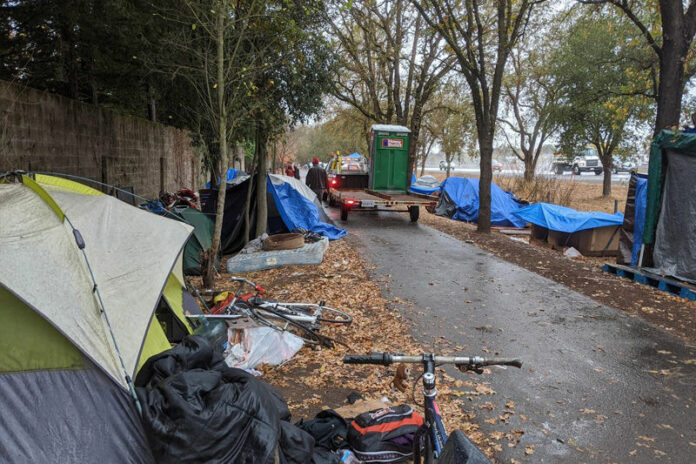At a special public meeting on Dec. 23, the Sonoma County Board of Supervisors unanimously approved a $12 million plan to address the homelessness crisis along the Joe Rodota Trail. The meeting came on the heels of a Dec. 17 meeting where the board of supervisors declared “a homeless emergency” on the trail and allocated an initial $25,000 for homeless outreach.
The $12 million plan includes the following elements:
Shared Housing: In a shared housing situation, individuals have a private bedroom but share common areas. The county is considering purchasing up to six multi-bedroom houses that will serve 60 people total and can be available within 100 days or less. One-time costs would include $5,000,000 in real estate costs, $500,000 for the relocation of current tenants and $50,000 in furniture costs. Ongoing costs include operation and maintenance.
Master Leases: In this scenario, a nonprofit would lease an entire rental property and then sublease it to people who are living on the trail. The county would subsidize the leases. This would yield six to seven units and could serve 20 individuals. Annual leases would amount to $750,000 and would be funded with $130,000 from reinvestment and revitalization dollars, $120,000 from the state’s Housing and Disability Advocacy Program and $500,000 from CalWORKs Eligible Support. One-time costs would include $60,000 for furniture, which would be funded through the county’s general fund for contingencies.
Indoor/outdoor shelters: The county staff will identify multiple indoor/outdoor sites with room for habitable structures, safe parking and RV hook-ups. Each site will be able to accommodate approximately 40 people currently living on the trail. One-time costs are estimated at $1,600,000 for two sites and $480,000 for one year of operating costs. The indoor/outdoor shelters would be funded by $3,900,000 from California’s competitive No Place Like Home permanent supportive housing program and $1,650,000 from the 2018-19 general fund.
The board decided to fasttrack a request for proposals (RFPs) for indoor/outdoor shelters such as container homes and tiny houses (which are popular with homeless advocates), as well as safe parking areas at locations such as the Sonoma County Fairgrounds. (Unfortunately, people could only stay in these types of shelters, whatever form they ultimately take, for 60 to 180 days, due to constraints against using state funds for non-standard, short-term housing of the homeless.)
County staff indicated that it would take about six months to set up indoor/outdoor shelters, much to the dismay of the supervisors and many homeless advocates who hoped this element could be done faster.
Support Services: Social services such as counseling and addiction treatment provide homeless clients the support they need to avoid falling back into homelessness. These services will initially be offered to clients currently living on the Joe Rodota Trail, but will follow them as they are placed in shared housing or the indoor/outdoor shelters.
Immediate action to improve life on the trail: According to a press release from the county, to improve conditions on the trail immediately, the county is addressing pest control, placing additional hand washing stations facilities, establishing needle disposal bins, providing trash removal and hiring private security to protect the well-being of the people on the trail.
The need for speed
All the supervisors stressed the urgency of the situation.
“Timing is critical,” said District 1 Supervisor Susan Gorin. “I want something set up in 30 days max, and we have county land available. Sixty days is not acceptable. Let’s send out RFPs this week, not next week.”
District 4 Supervisor James Gore called the homelessness situation on the Joe Rodota Trail not a “Canary in a coal mine,” but a “freight train in a tunnel.”
Geoffrey Ross, the executive director of the CDC, agreed.
“We recognize that urgent need needs urgent action,” he said.
Ross also said that the new funds would enhance the work the CDC has already done along the trail, noting that the agency has found shelter for 70 people on the trail and that almost all of the residents of the trail — 180 to 190 individuals — have been contacted about the housing options available to them.
Ross said the CDC will continue to purchase additional properties over the next couple of months with new units coming online in the next 24 to 36 months.
Homeless Action Sonoma County Co-founder Adrienne Lauby told the supervisors during public comment, “We have to do something that is quicker.”
During public comment, advocates held signs with phrases such as, “Shelter first” and “As many as we can.” Speakers mentioned several different shelter possibilities from container homes, to tiny homes, to elevated tents and safe parking sites. They also spoke about the necessity of getting people housed — in one way or another — as quickly as possible.
Ross noted that the CDC can work on sending RFPs out by early January in order to receive and review community and nonprofit proposals for indoor/outdoor shelters. Once RFPs are collected, the CDC will review the proposals and and present them to the board of supervisors.








